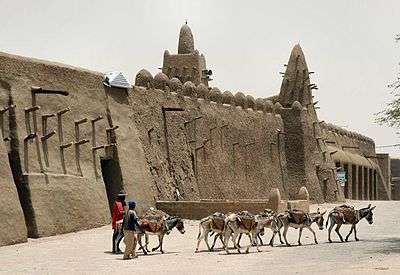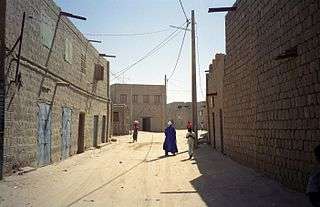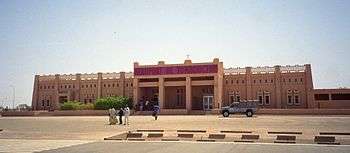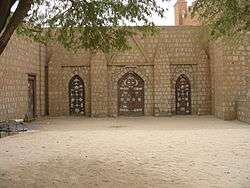Timbuktu
Timbuktu (also Tombouctou or Timbuctu) is a Tuareg city on the Niger River in the country of Mali.
| WARNING: Timbuktu lies at the heart of an ongoing war in Northern Mali between Islamist rebels and Malian soldiers, backed by West African & French forces. Although Timbuktu is now in control of the Malian government, backed by thousands of soldiers from other African countries, it will remain dangerous for the foreseeable future, as rebels (some belonging to terrorist organizations) remain in the nearby desert. Consult your government's travel advice before setting out. More information is available in the warning at the top of the Mali page. | |
| (Information last updated Feb 2018) |
Understand

| “ | My father can read big words, too. Like... Constantinople and Timbuktu. | ” |
—Dr. Seuss, 1963, "Hop on Pop" | ||
Its long history as a trading outpost that linked black Africa below the Sahara Desert with Berber and Islamic traders throughout north Africa, and thereby indirectly with traders from Europe, has given it a fabled status. Combined with its relative inaccessibility, "Timbuktu" has come to be used as a metaphor for exotic, distant lands.
Today, Timbuktu is an impoverished town, although its reputation makes it a tourist attraction, and it has an airport. It is one of the eight regions of Mali, home to the local governor. It is the sister city to Djenne (also in Mali).

Timbuktu is a UNESCO World Heritage Site since 1988. In 1990, it was added to the list of world heritage sites in danger, due to the threat of desert sands. A program was set up to preserve the site and in 2005, it was taken off the list of endangered sites only to suffer immeasurable damage at the hands of Islamist militants in 2012 and early 2013, destroying an undetermined amount of the area's cultural heritage. Fourteen of the Sufi mausoleums smashed by extremists were reconstructed by 2015, but much of the city remains damaged.
It was one of the major stops during Henry Louis Gates' PBS special Wonders of the African World. Gates visited with Abdel Kadir Haidara, curator of the Mamma Haidara Library together with Ali Ould Sidi from the Cultural Mission of Mali. It is thanks to Gates that an Andrew Mellon Foundation Grant was obtained to finance the construction of the library's facilities, later inspiring the work of the Timbuktu Libraries Project. Unfortunately, no practicing book artists exist in Timbuktu although cultural memory of book artisans is still alive, catering to the tourist trade. It is also home to an institute dedicated to preserving historic documents from the region.
The city is in stark contrast to the rest of the country's cities, because it has more of an Arabic flair than of an African. The streets are made of sand (except one), and one has often to go down to get into the houses, because of the sand which has leveled the streets higher than the entrances of the houses.
Get in

By car
You can come in a 12- to 24-hour trip by car from Mopti or have a hard 4x4 experience from Gao through the desert.
By boat
You can catch one of the many tourist pinnaces from Mopti (or slightly further downstream if the water level is low) they take 3 days to get there and are comfortable (at least mine was). During tourist season there will be plenty of people waiting to go so you can club together to hire one of the pinnaces. At night you will be camping on the shore and there will likely be a cook on the boat, they even have 'toilets' at the back. There are also local boats running up and down stream regularly but they are a little more cramped, but probably a lot cheaper.
By plane
You can fly into Timbuktu Airport (TOM IATA) from Bamako or Mopti (yes, the organization is very rural) and come by plane, although its schedule is extremely unreliable and unpredictable and flights are difficult to book from outside the country. Because of the conflict in the region, all flights have been suspended.
Get around
There are taxis, camels and donkeys - and not much more. That said you can easily walk from one end of the city to the other in under an hour. All the mosques are in the old town, which can be walked across in just a few minutes.
See
|
The Islamist rebel group Ansar Dine called for the destruction of all shrines and any mosques containing idols after capturing the city in June 2012. Most Sufi shrines in Timbuktu are believed to have been destroyed by the group. When French and Malian soldiers reached the city in Jan 2013, the fleeing rebels torched two important manuscript libraries. Most manuscripts were smuggled to Bamako but thousands of these important, irreplaceable relics are believed to have been destroyed. |
The three mosques of Djinguereber, Sidi Yahya and Sankore makes up of what have come to be known as the University of Timbuktu. They are closed for visitors during prayers and have time to time been completely off-limits for non-Muslims. All three are within a short walk of each other.
- 🌍 Djinguereber Mosque. Built in 1327 and is the largest and most impressive of the three mosques. There's an army barracks just to the south of the mosque, taking photos with caution is recommended.
- 🌍 Sidi Yahya Mosque.

- 🌍 Sankore Mosque. Has an impressive minaret and is worth a visit.
The Western explorers who were the "first" to find Timbuktu all have their houses preserved and commemorative plaques are visible on each of them. Alexander Gordan Laing, first Westerner to make it there and René Caillié, first Westerner to make it there and back among others. Most of these houses are private homes nowadays.
- 🌍 Heinrich Barth's House. German explorer Heinrich Barth made an incredible five-year journey across Sahara and reached Timbuktu in 1853. This tiny museum containing reproductions of Barth's drawings and extracts of his writings.
- 🌍 Timbuktu Ethnological Museum. Has an interesting mix of artifacts and contemporary folk art, albeit the museum feels a bit dusty. Some artifacts have however been stolen in the recent civil war. Also contains the original well of Bouctou around which the city was founded.
- 🌍 Flame of Peace Monument (Flamme de la Paix). Commemorates the ceremonial burning of 3000 weapons in March 1996, in honor of the end of the Tuareg rebellion. Many of the old guns are embedded in cement at the base of the monument. The monument is in a rather bad shape, perhaps fitting as the relations between the Tuareg and Mali government have deteriorated.
The Grand Marché is a two-story market with stalls and shops selling all kinds of things, it is well worth going just for the incredible view from the roof, across the whole of Timbuktu to the desert.
You can also hire a Tuareg and camels, however the "sunset tours" are too short to really appreciate the surroundings as the Tuareg camps are only a few hundred metres away from the edge of town. However it is interesting to visit one of the camps (usually just a small family group) and see the sun set over the desert. Even if you don't visit the camps it is worth walking to the dunes on the edge of the town just to see them. A tour over several days will however be fascinating. You may even go to do the 40-day trip to the salt fields. Negotiate with the Tuaregs, and not so-called "guides".
The flame of peace is a monument to the ceasefire of the Tuareg rebellion. It's just to the northeast of the Petite Marché. Although it is pretty new it is clearly falling apart already.
It is not a bad idea to take a child as guide, it prevents you from being hassled as much.
Don't forget to visit the tourist office so you can get your passport stamped with a Timbuktu stamp.
Buy
Take some salt along as well as the Tuareg sabres or knives. You'll be pretty hard pressed to get away from vendors selling all the same "unique" necklaces, earrings, knives and other handicrafts, so make sure to drive them down to a good price. A fair rule is to offer about a third of the first price they quote, then haggle so you pay half their first price. They are used to this and so always start at a high price. However, the things they sell are generally of good quality and great for souvenirs.
There is a shop (called 'objets artes boutique' or something similar) that sells the souvenirs to the sellers you see around town. If you head north from the Hotel Colom the road forks; take the left fork and about 100-200 m down the road, on the left hand side, is this shop. Prices are 6-10 times cheaper here, you cannot bargain but you may get a small (5-10%) discount for buying several items.
Another good idea is to get a postcard and post it, it will have the Timbuktu postal stamp on it. The Post office is down the main street south of the roundabout. The staff in there will give you the right stamps, you can sometimes buy postcards from there or from the many street vendors. Just don't expect to receive the postcard too soon; it can take over a month to get through to many Western countries!
Eat
|
Since the rebel occupation in 2012, it is not clear if these establishments are open due to a lack of visitors and Wikivoyagers to update these listings. |
- Hotel Le Colombe Restaurant, ☎ +223 292 14 35. CFA 4000.
There are a number of bar/restaurants around, including one on top of the Grand Marché. There is also a patisserie opposite the post office.
- Cat (see above)
Drink
You'd better avoid drinks as they are prepared from local tap water and are hazardous to your body. Remember to drink bottled water from shops; if you must drink tap water, it would be wise to boil it first.
A variety of "Western" drinks are available for purchase, sometimes at hotels from the counter. Coca Cola, original, diet or zero will make you lose liquids more quickly than you consume the drink, but the original version of the drink can help to replace sugars. Fanta is also available, but sometimes is lesser supply than Coke.
Keep drinking lots of water and carry a bottle with you at all times, even on short trips. Timbuktu can be extremely hot all year round and there are no bodies of water to cool off in, so your body is doing overtime on keeping yourself at a reasonable temperature.
Sleep
|
Since the rebel occupation in 2012, it is not clear if these establishments are open due to a lack of visitors and Wikivoyagers to update these listings. |
- 🌍 Hotel le Colombe, Bd Askia Mohammed, ☎ +223 292 14 35. Offers decent air-conditioned rooms. It also has a smaller annex further down the road, the Colomb II, which offers cheaper accommodation. Re-opened spring 2013 after the end of hostilities.
- 🌍 Hotel Campement Bouctou, ☎ +223 292 10 12. Cheaper.
- 🌍 Sahara Passion, ☎ +223 292 12 85.
- Hotel Hendrina Khan, ☎ +223 292 16 81.
- 🌍 Hotel Azalai, ☎ +223 292 11 63.